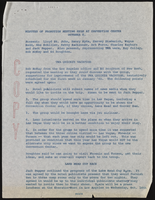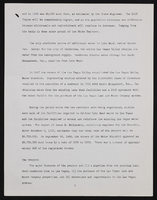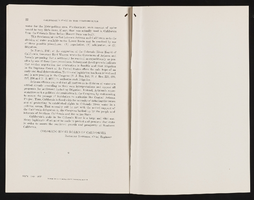Search the Special Collections and Archives Portal
Search Results
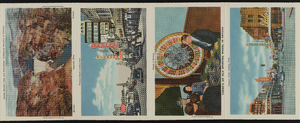
Artistic renditions of various views of Las Vegas, Nevada: postcards, image 007
Description
Four postcards. Hoover Dam; Fremont Street looking East; Wheel of Fortune; Fremont Street looking West.
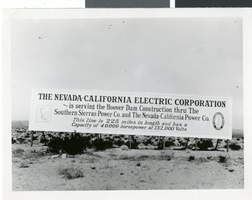
Photograph of a Nevada-California Electric Corporation sign, circa late 1920s - early 1930s
Date
1935
Archival Collection
Description
The Nevada-California Electric Corporation sign for the construction of the Hoover Dam. The sign reads: "The Nevada-California Electric Corporation is serving the Hoover Dam Construction thru The Southern Sierras Power Co. and The Nevada-California Power Co. This line is 225 miles in length and has a capacity of 40,000 horsepower at 132,000 volts."
Image
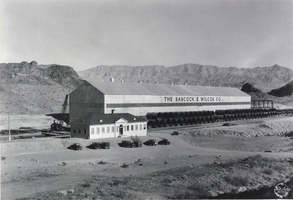
Photograph of Boulder City, Nevada, circa 1920-1955
Date
1920 to 1955
Archival Collection
Description
Picture of the Babcock and Wilcox (B&W) Company steel plant. B&W was the second largest contractor for the Hoover Dam project and built many of the houses that are still in Boulder City for their employees.
Image

Film transparency of the face of Hoover (Boulder) Dam, taken from the downstream side of the dam on the Arizona side, May, 1947
Date
1947-05
Archival Collection
Description
The face of Hoover (Boulder) Dam, taken from the downstream side of the dam on the Arizona side, May, 1947. The intake towers are visible in the background. The hydroelectric generators are visible in the foreground. During the years of lobbying leading up to the passage of legislation authorizing the dam in 1928, Hoover Dam was originally referred to "Boulder Dam" or as "Boulder Canyon Dam", even though the proposed site had shifted to Black Canyon. The Boulder Canyon Project Act of 1928 (BCPA) never mentions a proposed name or title for the dam. When Secretary Wilbur spoke at the ceremony starting the building of the railway between Las Vegas and the dam site on September 17, 1930, he named the dam "Hoover Dam", citing a tradition of naming dams after Presidents, though none had been so honored during their terms of office. After Hoover's election defeat in 1932 and the accession of the Roosevelt administration, Secretary Ickes ordered on May 13, 1933 that the dam be referred to as "Boulder Dam". In the following years, the name "Boulder Dam" failed to fully take hold, with many Americans using both names interchangeably and map makers divided as to which name should be printed. In 1947, a bill passed both Houses of Congress unanimously restoring the name to "Hoover Dam".
Image
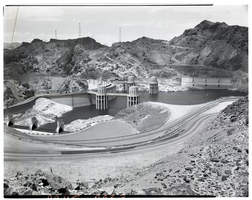
Film transparency of Hoover (Boulder) Dam, taken from the upstream side of the dam on the Arizona side, May, 1947
Date
1947-05
Archival Collection
Description
Hoover (Boulder) Dam, taken from the upstream side of the dam on the Arizona side, May, 1947. The intake towers, Nevada spillway house (in the background, behind the intake towers), and the Nevada spillway are visible. During the years of lobbying leading up to the passage of legislation authorizing the dam in 1928, Hoover Dam was originally referred to "Boulder Dam" or as "Boulder Canyon Dam", even though the proposed site had shifted to Black Canyon. The Boulder Canyon Project Act of 1928 (BCPA) never mentions a proposed name or title for the dam. When Secretary Wilbur spoke at the ceremony starting the building of the railway between Las Vegas and the dam site on September 17, 1930, he named the dam "Hoover Dam", citing a tradition of naming dams after Presidents, though none had been so honored during their terms of office. After Hoover's election defeat in 1932 and the accession of the Roosevelt administration, Secretary Ickes ordered on May 13, 1933 that the dam be referred to as "Boulder Dam". In the following years, the name "Boulder Dam" failed to fully take hold, with many Americans using both names interchangeably and map makers divided as to which name should be printed. In 1947, a bill passed both Houses of Congress unanimously restoring the name to "Hoover Dam".
Image
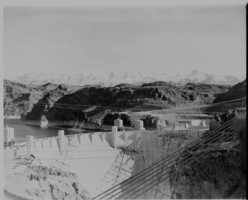
Film transparency of the face of Hoover (Boulder) Dam, taken from the downstream side of the dam on the Nevada side, May, 1947
Date
1947-05
Archival Collection
Description
The face of Hoover (Boulder) Dam, taken from the downstream side of the dam on the Nevada side. May, 1947. The intake towers are visible in the background. The Arizona spillway is visible at the far right of the photograph. During the years of lobbying leading up to the passage of legislation authorizing the dam in 1928, Hoover Dam was originally referred to "Boulder Dam" or as "Boulder Canyon Dam", even though the proposed site had shifted to Black Canyon. The Boulder Canyon Project Act of 1928 (BCPA) never mentions a proposed name or title for the dam. When Secretary Wilbur spoke at the ceremony starting the building of the railway between Las Vegas and the dam site on September 17, 1930, he named the dam "Hoover Dam", citing a tradition of naming dams after Presidents, though none had been so honored during their terms of office. After Hoover's election defeat in 1932 and the accession of the Roosevelt administration, Secretary Ickes ordered on May 13, 1933 that the dam be referred to as "Boulder Dam". In the following years, the name "Boulder Dam" failed to fully take hold, with many Americans using both names interchangeably and map makers divided as to which name should be printed. In 1947, a bill passed both Houses of Congress unanimously restoring the name to "Hoover Dam".
Image
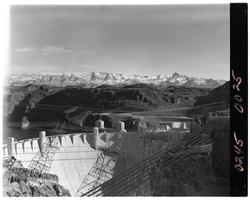
Film transparency of the face of Hoover (Boulder) Dam, taken from the downstream side of the dam on the Nevada side, May, 1947
Date
1947-05
Archival Collection
Description
Hoover (Boulder) Dam, taken from the downstream side of the dam on the Nevada side, May, 1947. The intake towers, several electric line towers, and the Arizona spillway are visible. During the years of lobbying leading up to the passage of legislation authorizing the dam in 1928, Hoover Dam was originally referred to "Boulder Dam" or as "Boulder Canyon Dam", even though the proposed site had shifted to Black Canyon. The Boulder Canyon Project Act of 1928 (BCPA) never mentions a proposed name or title for the dam. When Secretary Wilbur spoke at the ceremony starting the building of the railway between Las Vegas and the dam site on September 17, 1930, he named the dam "Hoover Dam", citing a tradition of naming dams after Presidents, though none had been so honored during their terms of office. After Hoover's election defeat in 1932 and the accession of the Roosevelt administration, Secretary Ickes ordered on May 13, 1933 that the dam be referred to as "Boulder Dam". In the following years, the name "Boulder Dam" failed to fully take hold, with many Americans using both names interchangeably and map makers divided as to which name should be printed. In 1947, a bill passed both Houses of Congress unanimously restoring the name to "Hoover Dam".
Image
Pagination
Refine my results
Content Type
Creator or Contributor
Subject
Archival Collection
Digital Project
Resource Type
Year
Material Type
Place
Language
Records Classification

